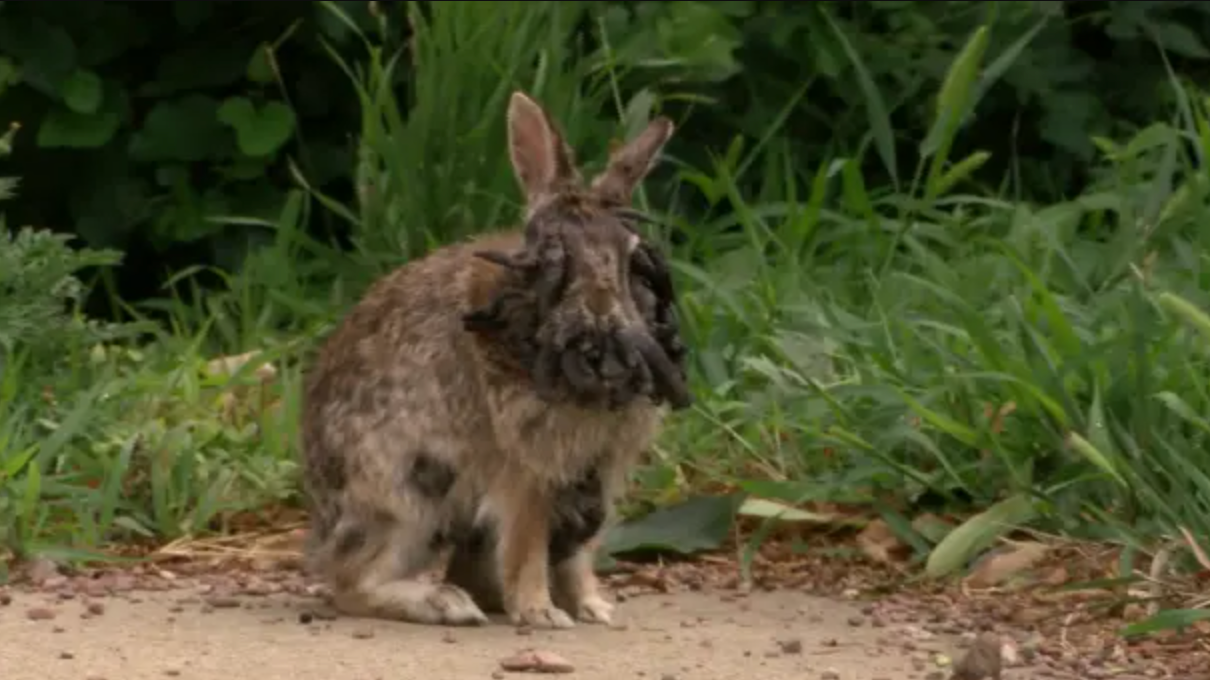Colorado's 'Tentacled' Rabbits: The Scientific Truth Behind the Viral 'Zombie' Virus and the Real-Life Jackalope
A bizarre phenomenon is captivating and concerning residents in Colorado and millions online: rabbits with strange, black "tentacles" or "horns" growing from their heads. The shocking images have gone viral, with terms like "zombie-looking rabbits" and "creepy tentacles" dominating social media feeds and news headlines. While the appearance of these animals is undeniably alarming, a fascinating and well-documented scientific reality underpins the mystery.
The public's initial reaction of curiosity, concern, and even fright is understandable. However, the bizarre growths are not the sign of a new plague or a mythical beast come to life. They are the symptoms of a specific, naturally occurring virus known as the Shope Papilloma Virus (SPV). This virus, far from being a new threat, has a rich history that directly connects to one of North America's most enduring pieces of folklore: the mythical jackalope.
This definitive guide will unravel the complete story behind Colorado’s "tentacled" rabbits. We will explore the viral sightings, dive deep into the science of the Shope Papilloma Virus, address the critical public safety questions, and trace the direct line from this biological anomaly to the legendary horned rabbit.

Unmasking the Mystery: What Are People Seeing in Colorado?
In recent weeks, particularly in the southeastern area of Fort Collins, Colorado, residents have reported numerous sightings of cottontail rabbits with disturbing black protrusions erupting from their faces and heads. The public's descriptions, while not scientifically precise, vividly capture the shocking appearance of these growths.
Community members and eyewitnesses have described them as:
- "Tentacles"
- "Horns"
- "Black quills"
- "Black toothpicks sticking out all around his or her mouth"
- A "scabbiesh-looking growth over their face"
One local resident, Susan Mansfield, provided a crucial observation, noting she had seen the same afflicted rabbit for a second consecutive year and that the growths had visibly enlarged over that time. This detail is significant because it suggests the condition can be chronic, with the tumors persisting and growing rather than being a transient issue.
These local sightings, amplified by media outlets like 9NEWS and the Coloradoan, were the catalyst that launched this phenomenon into the national and international spotlight, making it a viral topic across digital platforms. Recognizing these common, descriptive terms is essential for understanding the public's perception and the search intent of those seeking answers.
The Scientific Truth: A Deep Dive into the Shope Papilloma Virus (SPV)
Colorado Parks and Wildlife (CPW) officially confirmed that a viral infection is the cause of these unusual growths. The culprit is the Shope Papilloma Virus (SPV), also known as Cottontail Rabbit Papilloma Virus (CRPV) or Kappapapillomavirus 2. Discovered in 1933 by cancer researcher Richard E. Shope, SPV was a landmark discovery in viral oncology, providing the first mammalian model of a cancer caused by a virus.
What Exactly Are the "Tentacles"?
The growths that the public describes as "tentacles" or "horns" are scientifically known as keratinous carcinomas. In simpler terms, they are benign, wart-like tumors composed primarily of keratin, the same protein that makes up hair and fingernails.


- Appearance: The tumors typically appear as black or grayish horn-like growths on the outside, but have a white or pinkish-white flesh-like center if cross-sectioned. The dark external coloration is often due to an abundance of melanin pigment.
- Structure: They grow in a distinct pattern, with numerous tight, branching, threadlike processes connected by narrow cores of tissue. This structure is what gives them their bizarre, tentacled appearance.
- Location: These growths commonly appear on the rabbit's head, face, neck, ears, nose, and eyelids, and can sometimes be found near the anus.
The public's descriptions, while informal, are remarkably adept at capturing the bizarre physical manifestation of this disease.
How Does the Virus Spread?
Transmission of the Shope Papilloma Virus primarily occurs through two routes:
- Arthropod Vectors: The most common mode of transmission is through the bites of blood-sucking insects, particularly mosquitoes and ticks, that have previously fed on an infected rabbit. For managing these pests in your home and yard, you might find an amazing pest control spray helpful.
- Direct Contact: The virus can also spread through direct contact between rabbits.
SPV is notably resilient and can survive desiccation (drying out), which helps it persist in the environment and facilitates its transfer between hosts. This resilience can lead to certain areas becoming endemic zones for the virus.
Impact on Rabbit Health: Benign but Potentially Fatal
While the tumors caused by SPV are generally considered benign, they are far from harmless to the host animal. The presence and location of the growths can have severe, life-threatening consequences.
If tumors develop around the mouth or eyes, they can physically obstruct the rabbit's ability to eat, drink, or see. This can lead directly to starvation, dehydration, and increased vulnerability to predators, making the disease indirectly fatal.
Furthermore, the term "benign" can be misleading. In approximately 25% of cases, these papillomas can undergo a malignant transformation and become invasive squamous cell carcinomas. When this happens, the cancer can metastasize, or spread, to other parts of the body, commonly forming secondary tumors in the lungs, lymph nodes, kidneys, and liver, which is ultimately fatal.
Is There a Cure?
As of current scientific understanding, there is no known cure for the Shope Papilloma Virus. The virus can persist within an infected rabbit for years, even if the growths themselves sometimes regress on their own. In cases where the tumors interfere with vital functions, surgical removal is a common management approach to improve the animal's quality of life. Prevention strategies focus on reducing rabbit exposure to biting insects like ticks and mosquitoes.
Public Safety: Is the 'Zombie' Rabbit Virus a Threat to Humans and Pets?
The most urgent question arising from the viral images is whether this virus poses a risk to human and pet health. The answer, confirmed by wildlife experts, is a definitive no.
Colorado Parks and Wildlife has issued clear and consistent reassurance on this point, stating that the Shope Papilloma Virus is not dangerous to humans or domestic pets like dogs and cats. Despite extensive monitoring, there is no evidence that the virus can jump to or infect humans or other animal species outside of the rabbit family.
Despite these facts, the visually disturbing nature of the growths has fueled public fear, with online discussions speculating about the virus "jumping to humans". This highlights the power of a "visual shock factor" to override factual information. It's crucial to understand that the virus is species-specific and does not pose a public health threat.
What to Do If You See an Infected Rabbit: Official CPW Guidance
Given that there is no public health risk, officials advise a hands-off approach. This ensures the safety of both the public and the wild animals.
| CPW Action Guideline | Reason |
|---|---|
| Avoid Approaching, Touching, or Helping | While the virus is not dangerous to people, it is always best practice to give wild animals their space to minimize stress on the animal and avoid any unpredictable behavior. |
| Give Them Plenty of Space | Allowing the rabbits to behave naturally without human interference prevents them from feeling threatened. |
| Report Sightings to CPW | Public reports are an essential tool for wildlife disease monitoring. This data helps authorities track the prevalence and spread of the condition, contributing to citizen science efforts. |
Interactive Infographic: The Rabbit Phenomenon
From Virus to Legend: The Jackalope Connection Explained
One of the most captivating aspects of this story is its deep connection to folklore. The Shope Papilloma Virus is now widely accepted by scientists as the real-world biological inspiration for the myth of the jackalope, the legendary "warrior rabbit" of the American West described as having the horns of an antelope. To learn more about viral discoveries and the history of science, check out some amazing books on science history.
This isn't a new theory. The concept of horned rabbits dates back centuries, long before the American tall tale. Illustrations of rabbits with horns appear in historical texts like the Tableau encyclopédique et méthodique from the 17th century. Similar creatures are found in other cultures, such as the Bavarian wolpertinger and even a 13th-century Persian work depicting a rabbit with a single horn like a unicorn.
For centuries, these were thought to be either real hybrid species or mere fantasy. The scientific link was finally established in the 1930s. Richard E. Shope was intrigued by reports from hunters in Iowa who were shooting cottontails with peculiar "horns". His research led to the 1933 discovery of SPV, proving definitively that these "horns" were actually keratinous tumors caused by the virus. It became clear that generations of people who had reported seeing "horned rabbits" were, in fact, observing animals afflicted with this very real disease.
The American jackalope legend was famously popularized and commercialized in the 1930s by Douglas Herrick, a taxidermist from Douglas, Wyoming. He and his brother began grafting deer antlers onto jackrabbit carcasses, selling them to a fascinated public and cementing the jackalope's place in American folklore.
Frequently Asked Questions (FAQ)
- What are the "tentacles" on the Colorado rabbits? The so-called "tentacles" are actually horn-like, keratinous tumors caused by the Shope Papilloma Virus (SPV). They are composed of keratin, the same protein found in hair and nails.
- Can I get sick from a rabbit with Shope Papilloma Virus? No. According to Colorado Parks and Wildlife, the virus is not dangerous to humans, dogs, cats, or other domestic pets. It is a species-specific virus that primarily affects wild rabbit populations.
- Is the jackalope real? The jackalope as a hybrid of a rabbit and an antelope is a myth. However, the legend is strongly believed to have originated from sightings of real rabbits infected with the Shope Papilloma Virus, which causes horn-like tumors to grow on their heads.
- What should I do if I see an infected rabbit? The official guidance is to leave the animal alone. Do not attempt to touch, capture, or help it. Give it plenty of space and, if you wish to help wildlife officials, report the sighting to your local wildlife agency, like Colorado Parks and Wildlife.
- Is there a cure for the rabbit virus? No, there is currently no known cure for the Shope Papilloma Virus. While the growths may sometimes regress, the virus can remain in the rabbit's system for years.
Conclusion: A Modern-Day Cryptid Solved by Science
The phenomenon of Colorado's "tentacled" rabbits is a perfect storm of modern virality, public concern, and fascinating biology. It serves as a powerful reminder of how visually striking natural occurrences can ignite our collective imagination, echoing the way our ancestors might have reacted upon seeing these same animals centuries ago.
While the images are jarring, the science is clear. These are not monsters or zombies, but victims of the Shope Papilloma Virus—a condition that poses no threat to people but presents real survival challenges for the rabbits themselves. The story transforms a fleeting viral moment into a rich narrative about the enduring power of myth, the process of scientific discovery, and the importance of responsible wildlife observation in our modern, interconnected world.

Post a Comment